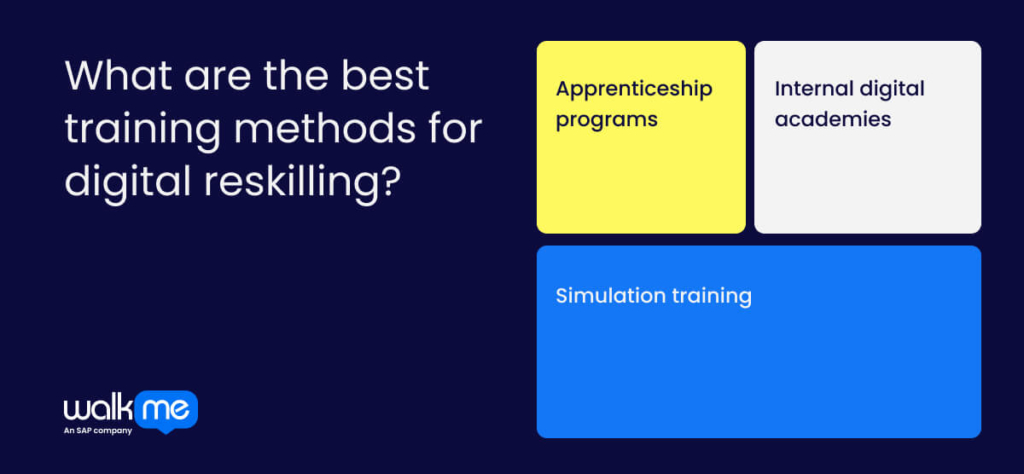Digital reskilling is a type of employee training that focuses on developing expertise in AI, cybersecurity, and other digital technologies to meet evolving business needs.
As businesses worldwide struggle with a shortage of qualified talent, reskilling is becoming a practical solution for many HR teams. The World Economic Forum has called this shift a “reskilling revolution,” recognizing that future demands will require entirely new capabilities.
While the causes of the talent shortage vary, one fact remains clear—employees need more training.
This article will explore digital reskilling in an enterprise setting, covering its definition, how it differs from upskilling, the most effective training methods, and why it plays a key role in IT and digital transformation.
What is digital reskilling?
Digital reskilling is a specialized form of reskilling that helps employees transition to new roles by developing skills in AI, cybersecurity, and other fields of digital innovation.
It allows staff to gain new expertise, update outdated skills, or shift career paths to stay relevant in a changing job market. For businesses, reskilling prepares the workforce for future demands, reduces layoffs, improves employee experience, and boosts productivity.
Businesses can even lower hiring and employee onboarding costs by developing existing talent. Every company must determine which skills to prioritize based on its goals and workforce, making reskilling a strategic, tailored approach.
Digital reskilling vs. digital upskilling
Digital reskilling and digital upskilling both help employees adapt to technological change, but they serve different purposes.
Digital reskilling shifts employees into new roles by equipping them with expertise in emerging technologies like AI and cybersecurity. It’s used when certain jobs disappear or when businesses need to move talent into different areas to meet changing demands.
Digital upskilling builds on existing skills, helping employees stay current with digital tools and technologies. It enhances their capabilities within their current roles rather than preparing them for new ones.
Both are crucial for a workforce that can keep pace with digital transformation.
What are the best training methods for digital reskilling?

Reskilling can use the full range of employee learning techniques that you will find within a company.
This section will introduce some of the different digital reskilling methods. We will investigate:
- Apprenticeship programs
- Internal digital academies
- Simulation training
Reskilling combines traditional and modern training methods, even for cutting-edge technologies. Traditional approaches remain useful for developing specialists, but large-scale reskilling often requires entirely new strategies.
Apprenticeship programs
Apprenticeship programs offer hands-on experience, allowing employees to develop practical skills alongside real-world experts, encouraging growth and innovation within the organization.
Through practical training, apprentices develop proficiency in software development, data analysis, cybersecurity, and digital marketing, gaining industry-recognized certifications and credentials along the way.
Internal digital academies
Internal digital academies are an innovative company-wide strategy for reskilling. Unlike generalized online learning platforms, digital academies are tailored to a company’s unique culture and narrative.
They offer experiential and organization-specific programs across the enterprise. These programs train employees for technical career paths, equip knowledge workers with specific technologies, and raise managers’ and executives’ awareness of technology’s impact on different business areas.
Companies like DuPont, Gestamp, and Deloitte have effectively implemented this model. An internal academy can also support reskilling, upskilling, and other targeted interventions.
Simulation training
Simulation training offers a great way to reskill employees already embedded in your company.
After all, reskilling involves individuals who already possess a solid understanding of your company. They understand their current roles and future tasks, immersing participants in the tangible aspects of their prospective roles and ensuring they are not indefinitely confined to a classroom setting.
This hands-on approach connects theoretical knowledge with practical application, providing a valuable combination for individuals upskilling in real-world scenarios.
How to implement digital reskilling
Employers seek a wide range of skills, with the WEF’s Reskilling Revolution taxonomy highlighting many that companies value today.
While all are important, IT stands out as the key area for reskilling across sectors. Over the past two decades, digital technologies have evolved rapidly, leaving traditional education and training programs struggling to meet business demands for tech talent.
In this section, we’ll explore the IT talent shortage, outline the basics of IT reskilling, and provide practical suggestions for implementation.
The skills gap in IT and technology

The World Economic Forum’s Future of Jobs Report 2025 shows that talent shortages will continue globally and locally, making it the biggest challenge for organizational transformation.
To address this, companies plan to invest more in reskilling and upskilling employees and expand diversity initiatives to attract a wider range of candidates.
The top ten most common shortage areas, according to the Forbes report, are as follows:
- Artificial intelligence and machine learning
- IT support and troubleshooting
- Cybersecurity
- Data analysis and data science
- Programming
- Cloud computing
- Mobile app development
- Project management
- Network administration
- DevOps and automation.
All of these areas have developed significantly in the past few years. Indeed, the role of generative AI has transformed in a very short space of time.
Any list of “most needed digital skills” can be misleading. Reskilling for IT and digital expertise is particularly challenging due to the fast pace of technological change, constant updates to software and tools, and the ever-shifting digital landscape.
Therefore, it is essential to build agility into IT reskilling programs, enabling a workforce that can quickly adapt to new trends and innovations.
How to implement a digital reskilling program
Implementing a digital reskilling program is similar to implementing any training and development initiative.
The basic steps you need to take include the following:
- Identify internal skills needs
- Find appropriate employees
- Choose a relevant method
- Deploy training and monitor
- Evaluate the program
Reskilling depends on aligning the right skills with the right people, often requiring employees to tackle unfamiliar work. Each step in the process involves more complexity than it may seem.
The next section explores how past business experience offers valuable lessons for IT reskilling.
Tips for successful IT reskilling
Managing a digital reskilling initiative starts with a simple process. However, each step has its own challenges, opportunities, and peculiarities. If you’re aiming to reskill staff in this area, think about the following points:
- Thorough needs assessment: Standard Chartered’s case study (CIPD) highlighted the value of interviews, workshops, and ongoing discussions to pinpoint essential skills.
- Prioritizing skills: Deciding which skills matter most can be complex, but tools like McKinsey’s 2023 report help identify urgent needs—such as AI and people management—while deemphasizing less critical areas.
- Balancing reskilling with other methods: Reskilling isn’t always necessary. Upskilling, mandatory training, and contextual help can address smaller gaps without overhauling career paths.
- Organizational impact: BCG’s analysis describes reskilling as a broad effort involving recruitment, training, job matching, and workforce planning—it’s more than a quick fix.
Staying informed: Leadership must keep up with emerging tech to align training with business needs. Resources like the Harvard Digital Reskilling Lab offer valuable insights.
Who’s it for?
Digital reskilling isn’t just for tech companies. Manufacturing, healthcare, finance, and retail use it to modernize operations, helping employees integrate digital tools and stay competitive.
Enterprise leaders must invest in reskilling despite uncertainties. Large companies can afford risks, even if some predictions about future skills are off.
For SMEs, reskilling is crucial but harder to implement. The OECD notes that closing the digital skills gap is key to SME digital transformation.
Look to the future with digital reskilling
This article has focused on reskilling in technology, but this is just one area where companies may need support.
WEF’s 2024 report highlights that sustainability is another key area where many companies must rethink their reskilling initiatives. LinkedIn research also shows that even in white-collar office jobs, employees need a wide range of soft skills, competencies, and abilities.
Businesses must consider a broader approach to reskill beyond digital skills. Whether adapting to sustainability goals, developing leadership capabilities, or enhancing problem-solving skills, companies that invest in diverse reskilling strategies will be better equipped for future challenges.
Digital training investments are crucial for businesses, but a strong reskilling program must be tailored to your company’s unique needs, industry, location, and growth strategy.
FAQs
Digital reskilling helps employees adapt to evolving technologies, keeping businesses competitive. As automation and AI reshape industries, workers need new skills to stay relevant. Companies benefit from improved efficiency, innovation, and reduced hiring costs. Without reskilling, businesses risk talent shortages, and employees face job displacement.
According to the WEF, 44% of workers’ skills will need updating by 2027. McKinsey reports that 87% of companies face or expect skill gaps soon. These figures highlight the growing need for reskilling initiatives.
Reskilling trains employees for new roles, while upskilling enhances existing skills. This means learning AI, cybersecurity, data analysis, and automation. Businesses use online courses, apprenticeships, and on-the-job training to develop talent, ensuring employees can work with emerging technologies and stay competitive.

